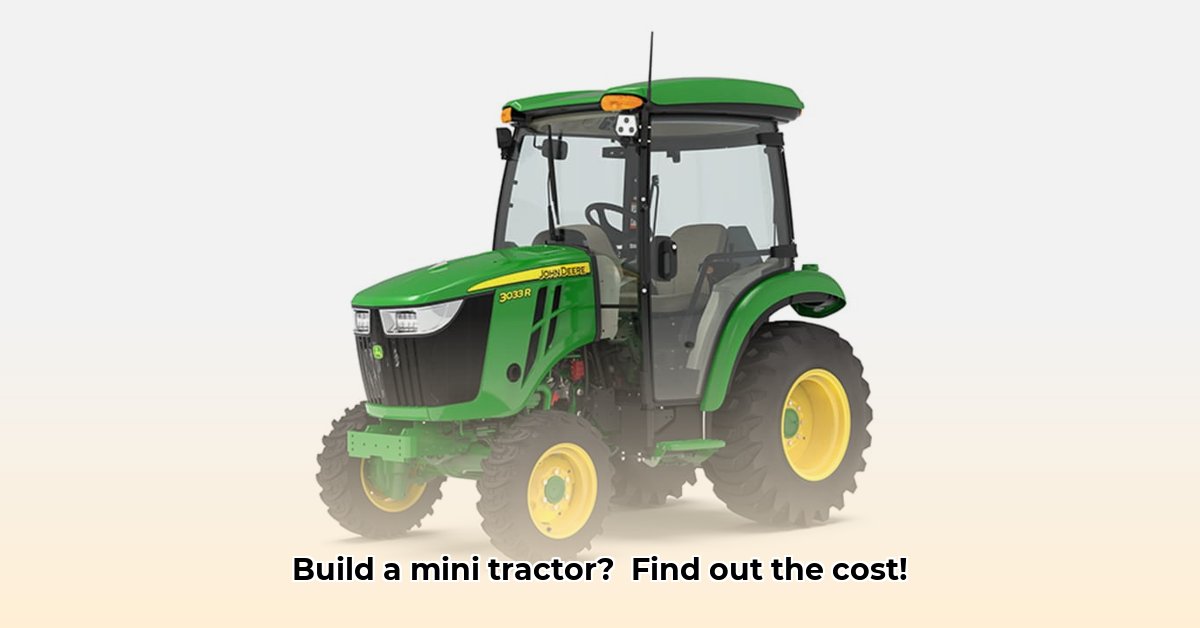
Building your own mini-tractor can be a rewarding project, potentially saving you thousands of dollars compared to buying a new one. But how much will it actually cost? This step-by-step guide provides a realistic cost breakdown and practical instructions to help you build your own mini-tractor. For more mini-tractor resources, check out this helpful website.
Assessing Your Needs and Design
Before you begin, determine your mini-tractor's intended tasks. This dictates engine power, size, and features. A simple design sketch helps visualize the build and identify necessary components. Reusing or salvaging existing parts is a fantastic way to cut costs. Could old equipment parts be repurposed? This crucial planning stage sets the foundation for a successful and cost-effective build.
Sourcing Components: The Key to Budget Control
Smart sourcing is critical for managing costs. Where will you find the parts?
1. Engine: The Heart of the Matter
Used engines are significantly cheaper than new ones. Online marketplaces, salvage yards, and local mechanics are all potential sources. A smaller, reliable engine is often sufficient for many mini-tractor tasks. Remember to thoroughly check the engine’s condition before purchasing.
2. Transmission: Smooth Operation
A salvaged manual transmission from a vehicle can work very well, providing excellent control and a longer lifespan at a fraction of the cost of a new unit. Ensure compatibility with your chosen engine.
3. Axles and Wheels: Getting Mobile
Salvage yards are treasure troves for cost-effective axles and wheels. Look for suitable options from older farm equipment or utility vehicles. Inspect them carefully for wear and tear before committing to a purchase.
4. Frame and Chassis: The Foundation of Your Tractor
Building your own frame is likely the most economical approach. You’ll need steel, welding equipment (rentable), and basic metalworking skills. Consider pre-fabricated frames if DIY welding is not feasible.
5. Other Essential Components: Steering, Brakes, and More
Steering components, brakes, and seating can be sourced from multiple places, prioritizing used or affordable new options. This is where careful planning and research will pay dividends.
Detailed Cost Breakdown: A Realistic Budget
The actual cost will vary based on your choices and geographical location. These are estimates for a basic mini-tractor build:
| Component | Low-Cost Estimate (USD) | Mid-Range Estimate (USD) | High-Cost Estimate (USD) | Notes |
|---|---|---|---|---|
| Used Engine | $300 | $600 | $1000 | Condition greatly impacts price; thorough inspection is essential. |
| Used Transmission | $150 | $300 | $500 | Ensure compatibility with engine. |
| Axles & Wheels | $100 | $200 | $400 | Salvage yards are an excellent source. |
| Steel for Frame | $100 | $250 | $500 | Varies with frame design complexity. |
| Welding Supplies (rental) | $50 | $100 | $200 | Renting is significantly cheaper than purchasing welding equipment. |
| Other Components | $150 | $400 | $700 | Includes steering, seat, basic hydraulic components (if needed), etc. |
| Total Estimated Cost | $850 | $1900 | $3300 | This range reflects significant variability in used part pricing. |
Building Your Mini-Tractor: A Step-by-Step Guide
This phase demands meticulous planning and execution. Safety is paramount. Always prioritize safety measures whenever working with heavy machinery or tools.
Frame Construction: Weld the frame according to your design. Ensure it’s sturdy enough to handle weight and stress.
Engine Mounting: Securely mount the engine to the frame. Pay close attention to alignment and stability.
Transmission Installation: Carefully connect the transmission to the engine, ensuring proper alignment and smooth operation.
Axle Assembly: Attach the axles to the frame, ensuring correct wheel alignment for safe and effective operation.
Steering and Brake Installation: Mount and connect the steering mechanism and brakes. Test thoroughly before proceeding.
Final Assembly: Install the seat, and other necessary components. Double-check all connections and ensure everything is functioning correctly.
Testing and Refinement: A Crucial Final Step
After assembly, meticulously test the mini-tractor’s operation in a safe, controlled environment. Make adjustments to steering, brakes, or other components to achieve optimal performance. This fine-tuning is vital for a reliable and safe machine.
Key Takeaways: Building Your Mini-Tractor Successfully
- Building a homemade mini-tractor is a challenging yet rewarding project that requires skill and careful planning.
- Sourcing used parts significantly reduces costs.
- Accurate cost estimations are crucial for effective budgeting.
- Safety remains a top priority throughout the entire process.
- Thorough testing and refinement are essential for a fully functional and safe mini-tractor.
This comprehensive guide provides a robust framework for building your mini-tractor. Remember to adapt it to your specific needs and resources. Happy building!